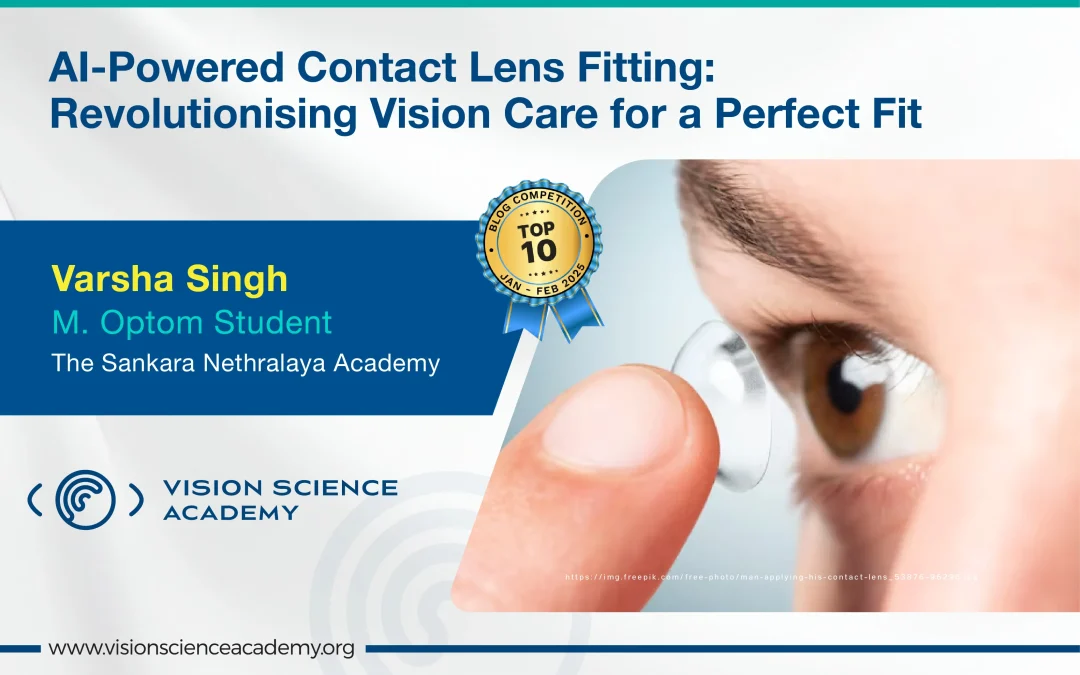Varsha Singh, B.Optom.
M. Optom. Student, The Sankara Nethralaya Academy, Chennai, India
Traditionally, contact lens fitting relied on trial and error, requiring skill and experience. AI now revolutionises the process by quickly analysing patient data, using machine learning and corneal topography to assess eye characteristics like curvature and refractive error, enabling more precise and personalised lens recommendations. (1-4)
In addition to improving accuracy, AI technology is continuously learning from each fitting, allowing the system to become more intuitive over time. (5-7) AI-driven solutions enable practitioners to deliver accurate fittings quickly, enhancing patient satisfaction while reducing discomfort and vision issues.
Advantages of AI-Driven Fittings
- Improved Fitting Accuracy
AI-based methods improved fitting accuracy, increasing success rates by 15% and reducing follow-up adjustments. By utilising corneal topography data, the AI system more effectively predicted the optimal lens. (6) - Reduction in Fitting Errors
AI systems led to a reduction in fitting errors, with AI being more efficient in accommodating complex corneal shapes and asymmetry. (5) - Optimised Comfort and Visual Outcomes
In a clinical trial, AI-based fitting improved patient comfort by 25% and visual clarity by 20%, as patients experienced fewer lens-related issues like dryness or discomfort. (4–6) - Faster Fitting Process
The AI-driven lens fitting process is 40% faster compared to traditional methods, allowing eye care professionals to make quick, data-driven decisions for more accurate prescriptions. (4) - Personalised Solutions for Complex Cases
AI improved outcomes by 35% for patients with keratoconus or high astigmatism, creating more precise lens designs by accounting for irregular corneal topography, compared to trial lenses. (5,6,8)
Role of AI in Offering Customised Fittings
AI revolutionises contact lens fitting by using patient-specific data like corneal topography, refractive measurements, and tear film quality. It creates customised lens designs for improved comfort and clarity, adjusts for prescription, and enhances stability by addressing tear film quality, reducing dryness and shifting. This data-driven approach ensures a more precise fit, fewer follow-up visits, and better overall comfort than traditional methods. (4,6)
AI can map the cornea and adjust lens design, reducing visual aberrations like blurriness and distortion. AI-based fittings outperform traditional trial lens fittings, achieving up to a 30% higher success rate in orthokeratology for myopia control. This improvement is due to better matching of the lens to complex corneal geometry. (9)
AI for Complex Conditions: Optimising Fit for Keratoconus and More
AI has significantly enhanced contact lens fitting for patients with complex corneal conditions like keratoconus and high astigmatism. Technologies like FITSCAN use AI to analyse corneal topography and create customised lens designs, improving fit accuracy, reducing discomfort, and enhancing visual clarity. Additionally, AI reduces the number of fitting trials, streamlining the process. (8) AI-driven systems improve fitting success by 30% in orthokeratology for irregular corneas, offering better alignment and stability than traditional methods. This makes AI especially valuable for patients with complex corneal shapes, providing superior visual outcomes. (4)
Conclusion:
AI is transforming contact lens fitting by improving precision, efficiency, and patient outcomes. As technology advances, AI will allow for more personalised fittings that adapt to various corneal shapes. Integrating augmented reality and advanced data analytics will further customise lens solutions. These advancements are expected to set new standards, offering quicker, more effective, and comfortable solutions for various eye conditions.
References:
- Lan, W.-Z., Tang, H., Wen, L.-B., Chen, Z., Zhou, Y.-L., Dai, W.-W., … Tang, Y. (2024). Artificial intelligence-assisted prescription determination for orthokeratology lens fitting: From algorithm to clinical practice. Eye & Contact Lens, 50(7), 297–304.
- Fan, Y., Yu, Z., Tang, T., Liu, X., Xu, Q., Peng, Z., … Zhao, M. (2022). Machine learning algorithm improves accuracy of ortho-K lens fitting in vision shaping treatment. Contact Lens & Anterior Eye: The Journal of the British Contact Lens Association, 45(3), 101474.
- Visser, E.-S., Wisse, R. P. L., Soeters, N., Imhof, S. M., & Van der Lelij, A. (2016). Objective and subjective evaluation of the performance of medical contact lenses fitted using a contact lens selection algorithm. Contact Lens & Anterior Eye: The Journal of the British Contact Lens Association, 39(4), 298–306.
- Koo, S., Kim, W. K., Park, Y. K., Jun, K., Kim, D., Ryu, I. H., … Yoo, T. K. (2024). Development of a machine-learning-based tool for overnight orthokeratology lens fitting. Translational Vision Science & Technology, 13(2), 17.
- Abadou, J., Dahan, S., Knoeri, J., Leveziel, L., Bouheraoua, N., & Borderie, V. M. (2025). Artificial intelligence versus conventional methods for RGP lens fitting in keratoconus. Contact Lens & Anterior Eye: The Journal of the British Contact Lens Association, 48(1), 102321.
- Zhou, X., Zeng, L., Shen, Y., Zhang, Z., Wang, C., Wang, B., … Chen, Z. (2024). Artificial intelligence-assisted fitting method using corneal topography outcomes enhances success rate in orthokeratology lens fitting. Contact Lens & Anterior Eye: The Journal of the British Contact Lens Association, (102350), 102350.
- Yang, H.-W. W., Liang, C.-K. L., Chou, S.-C., Wang, H.-H., & Chiang, H. K. (2024). Development and evaluation of a deep neural network model for orthokeratology lens fitting. Ophthalmic & Physiological Optics: The Journal of the British College of Ophthalmic Opticians (Optometrists), 44(6), 1224–1236.
- Mandathara, P. S., Fatima, M., Taureen, S., Dumpati, S., Ali, M. H., & Rathi, V. (2013). RGP contact lens fitting in keratoconus using FITSCAN technology. Contact Lens & Anterior Eye: The Journal of the British Contact Lens Association, 36(3), 126–129.
- Chong, L., Sun, Z., Wang, Y., Gu, T., Lin, W., Du, B., & Wei, R. (2025). Comparison of trial lens-fitting and software-fitting in orthokeratology for myopia control in children with high corneal eccentric value. Contact Lens & Anterior Eye: The Journal of the British Contact Lens Association, 48(1), 102334.


Recent Comments